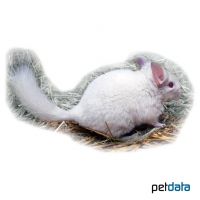White Chinchilla (Chinchilla chinchilla 'White')
| White Chinchilla Chinchilla chinchilla 'White' | |
|---|---|
| Name | White Chinchilla |
| Name Lat. | Chinchilla chinchilla 'White' |
| Family | Chinchillas |
| Family lat. | Chinchillidae |
| Order | Rodents |
| Order lat. | Rodentia |
| Origin | South America (breeding variety) |
| Climate | Temperate |
| Habitat | Rocky areas, shrub-steppe |
| Diet | Hay, herbs, flowers |
| Behavior | Nocturnal |
| Keeping | Pair, group |
| Care Level | Moderate |
| Life Span | 10-15 years |
| Protection | No |
| Metric Units | |
| Size | 20-30 cm |
| Temperature | Room temperature |
| Housing | A: 1 m² / H: 1.5 m |
| US Units | |
| Size | 7.9"-12" |
| Temperature | Room temperature |
| Housing | 10 ft² / 60" hight |
Distribution and habitat
The white chinchilla is a color morph. Chinchillas kept as pets are the domesticated breeding form of animals living in the wild in the Andean region. They inhabit arid plains with sparse shrub and tree cover, as well as rocky mountain slopes and scree slopes from 900 to 5,000 meters above sea level. Predominantly crepuscular to nocturnal, they live in rock crevices and caves during the day.
Maintenance
Minimum dimensions for the enclosure:
| 2 animals | area: 1 m² | height: 1,5 m |
| Each additional animal | Area: + 0,5 m² |
However, an enclosure with a base area of 2 m² is recommended, placed in a bright (no direct sunlight), draught-free and quiet place, with ventilation openings at the sides, and it must not be tightly closed at the top.
The cage should be equipped with stones, roots and branches, as well as at least three perches placed at different heights (tiers), which can be reached only by jumping. They need a sleeping house and a sand bath with chinchilla special sand for grooming. The floor must be evenly covered with absorbent litter (small animal litter, hemp litter, beech granules, etc.) and always kept clean and dry. Mineral cat litter or straw is not suitable. Nail material, such as fresh twigs from deciduous trees (willow, hazelnut) must always be available. The room temperature should be 15-21 °C. Temperatures above 25 °C are not tolerated. Attention must be paid to the natural day-night rhythm of the animals.
Diet
They are herbivores and require a diet rich in crude fiber and low in fat. The species-specific food supply consists mainly of high-quality hay, which should be offered in a hayrack, supplemented with special feed for chinchillas available in specialized stores, dried herbs and rose hips, and a mineral stone as a nutritional supplement. Fresh fruits and vegetables should rarely be offered in very small quantities. Water must always be available in hanging bottles or in stable, open containers and, like food, must be offered fresh daily. Water and food containers must be arranged so that they cannot become soiled.
A varied diet promotes health and prevents deficiency symptoms.
Behaviour and compatibility
They need contact with conspecifics and should only be kept in pairs or in a group, such as a male with several females (harem family) or a female group. Socialization is not always problem-free and is most likely to succeed with young animals. At the first signs of incompatibility, the animals must be separated immediately.
Reproduction and breeding
In the male, the anal and genital openings are farther apart than in the female.
They are able to reproduce all year round. After a gestation period of about 111 days, up to 4 young are born fully developed, hairy and with sight, and leave the nest after a few hours. After the suckling period (5-6 weeks) the young can be separated from the mother. They are sexually mature after 3-5 months. Chinchillas live 10-15 years.
Important
By grasping quickly at the root of the tail, the animal becomes almost immobile and can be grasped under the belly and lifted up. They must not be grasped by the tail because of the risk of breakage, and not from above, as this may cause parts of the fur to be shed. The length of the teeth should be checked regularly and if necessary they should be shortened by the veterinarian
They have the densest fur of all land mammals, so their fur was highly sought after by the Incas. It protects them from low temperatures, but not from wetness, accordingly they are very sensitive to wet cold
In pet keeping, mostly species hybrids occur (long-tailed with short-tailed chinchillas). They are bred in numerous colors. The wild population is highly endangered and strictly protected (WA Appendix I; EU Appendix B). The domesticated forms are not subject to species protection!
You can find further literature in your pet store
References
Text: petdata; Image: petdata
Source: W. PUSCHMANN, D. ZSCHEILE, K. ZSCHEILE (2009): Zootierhaltung - Tiere in menschlicher Obhut: Säugetiere, Harri Deutsch Verlag; BMEL (2014): Gutachten über Mindestanforderungen an die Haltung von Säugetieren; Tierärztliche Vereinigung für Tierschutz e.V. (2012): Merkblatt für Tierhalter - Chinchillas
- Gemäß § 21 Abs. 5 Tierschutzgesetz idgF
